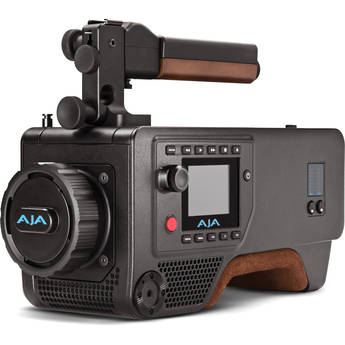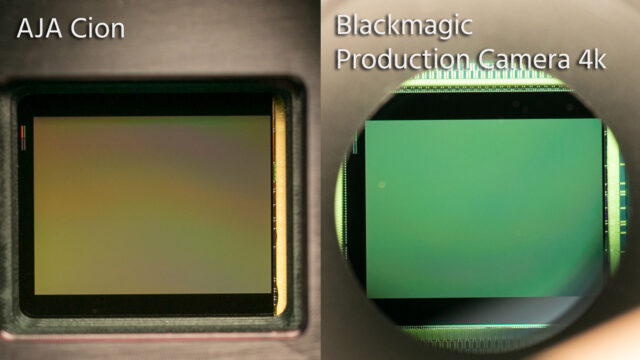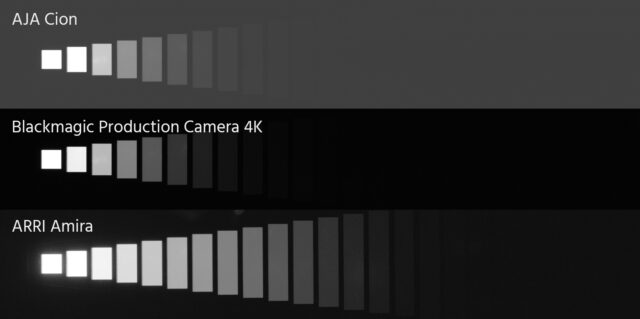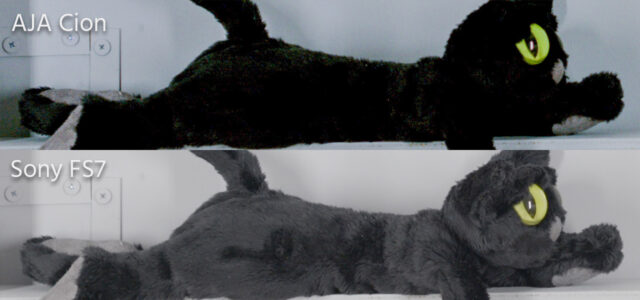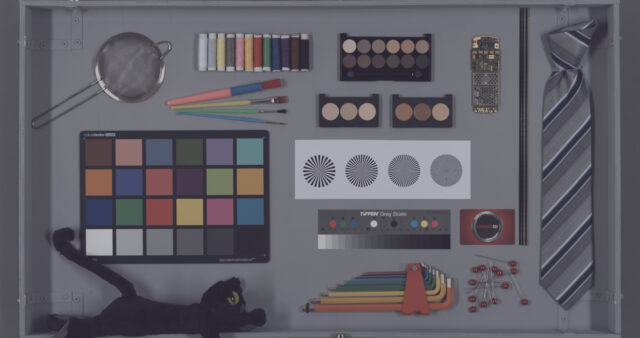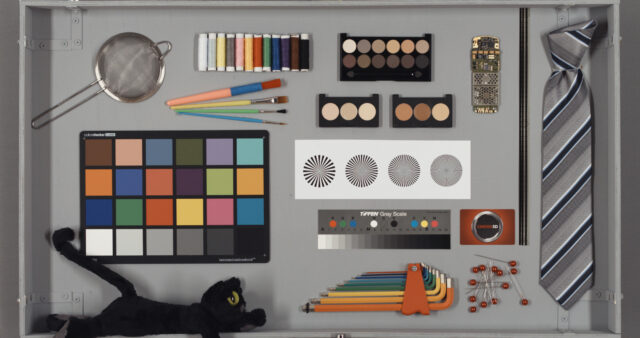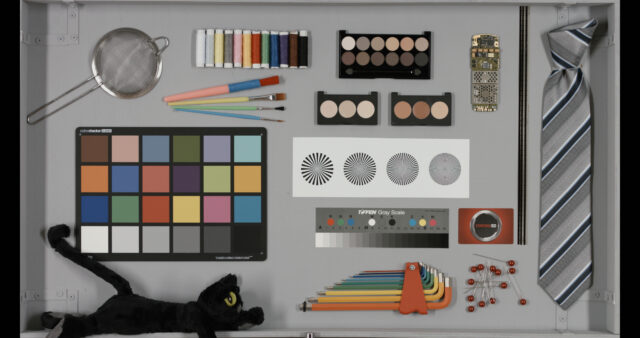AJA Cion Review – All You Need to Know About the AJA Camera
PAGE 2
← GO TO PAGE 1
• Page 2: AJA CION Review – Sensor Tests
• Page 3: AJA CION Review – Ergonomics & Handling
• Page 4: AJA CION Review – Pro’s & Con’s | Conclusion
AJA Cion Review – Sensor Tests
There was a rumor that AJA used the same sensor for their CION that Blackmagic had used in their Production Camera 4K. We were curious so we took a closer look at both sensors.
We were quite surprised to see that both the dimensions as well as the pin layout look identical on both camera’s sensors. (We do not claim it is the same sensor). The CION has a rectangular frame that overlay’s some pins and a different colour glass filter.
Also the sensor is positioned in a 180° reverse angle when comparing the cameras.
The sensors also performed very similarly in terms of lowlight and dynamic range.
Dynamic Range:
We are using a DSC Labs Xyla-21 test chart in a dark room with the same interchangeable mount Zeiss CP2 50mm T2.1 Makro Cine lens for all our tests.
The Gamma Setting that gave us the best dynamic range on the CION was “Expanded 1” with colour setting “flat”. This is also the setting AJA recommends for optimal dynamic range.
We could get 8.2 stops of usable dynamic range from the AJA CION. Interestingly it is the exact same rating we measured on the Blackmagic Cinema Camera 4K.
Here is a framegrab from our test. Each patch represents one stop of dynamic range starting with the third patch. We are measuring our test charts with Imatest software to assign an objective rating. We confirm this rating with a histogram. Each sensor has a life of its own and needs careful inspection.
The AJA CION (ISO 320 & ISO 500) and the Blackmagic Production Camera 4K (ISO 200 & 400) have a different way of processing the image, but eventually the software rated both cameras with the same dynamic range of 8.2 stops (usable) at their low and mid ISO speeds. This is the lowest dynamic range we have measured on any camera (15 and counting).
The last three visible steps on the AJA CION are shades of grey that disappear in black and are not usable in a real world scenario.
The Arri AMIRA which you can see in comparison was rated at 13.1 stops.
The FS7 in comparison reaches 12.4 stops and most Canon cameras come in at around 10-11 stops.
Lowlight Performance:
The lowlight performance of the AJA Cion is one of its weak points. AJA rates their highest ISO setting (with Gamma “Expanded 1”) for the CION at ISO 500. Due to the very good noise performance the material can be slightly pushed (brightened up), but this is limited due to the low dynamic range.
The AJA CION can be set to ISO 800 and ISO 1000 when Gamma is set to “Normal”. This however reduced the dynamic range to 5.7 stops. The resulting images seemed dark even when exposed + 1 stop.
Below we have a comparison between an image from the AJA CION (Gamma: Normal) pushed 4 stops with shadows brightened up and an image on the Sony FS7 (Slog2) pushed 1 stop. The aperture on both tests was an identical T/4.0.
Colours:
Observing the colours on the AJA CION it becomes apparent that this is where the camera shines. Skin Tones were beautiful and isolated, colours were very filmic and organic and most Gamma Modes produce just beautiful results when not over or underexposed.
This is how a 4K image from the AJA Cion in Gamma “Expanded 1” looks like. This was exposed +1/2 stop higher than our light meter suggested. It looks like the camera exposes rather low.
Here is the same shot slightly graded (There is no r.709 LUT by AJA yet. Magic Bullet Film worked well on this particular footage):
And the same shot from the Blackmagic (also graded with Magic Bullet Film):
These grades are not perfect. It was just an attempt to quickly match the two cameras for easier comparison.
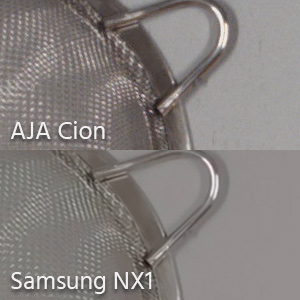 On the left is a 100% crop of the AJA CION compared to the Samsung NX1. The CION seems to resolve more detail while the NX1 seems to handle the highlight rolloff better.
On the left is a 100% crop of the AJA CION compared to the Samsung NX1. The CION seems to resolve more detail while the NX1 seems to handle the highlight rolloff better.
Below is a colour comparison between the AJA CION (graded) and the NX1 (ungraded).
You can see how the Samsung has less detail in terms of colour resolution. Both cameras it seems handle colours quite well.
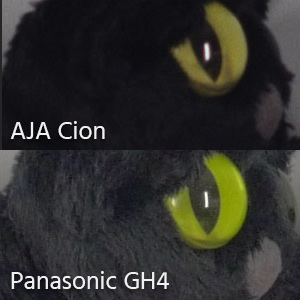 In the shadows there is detail that can be pulled back a little, but not as much as on the Panasonic GH4. However the codec of the GH4 seems very destructive in comparison.
In the shadows there is detail that can be pulled back a little, but not as much as on the Panasonic GH4. However the codec of the GH4 seems very destructive in comparison.
The AJA CION image was exposed 1 stop higher than the GH4. The AJA Cion seems to have a low inherent brightness.
Below we see some skin tones compared between the AJA CION (graded) and the Panasonic GH4 (ungraded).
Overall the AJA CION has very good image detail in all its formats 4K, UHD, 2K and HD, while there is always a certain organic softness to the image, which may not be a disadvantage. It also seems to have a nice colour reproduction and some problems with highlights. We noticed they easily get oversaturated and clip. It seems to be important to expose wisely when using the AJA CION.
There are no apparent aliasing or moiré issues on the AJA Cion.
GO TO PAGE 3 → Ergonomics & Handling
• Page 2: AJA CION Review – Sensor Tests
• Page 3: AJA CION Review – Ergonomics & Handling
• Page 4: AJA Cion Review – Pro’s & Con’s | Conclusion
